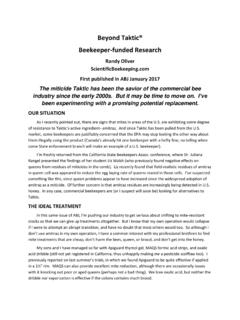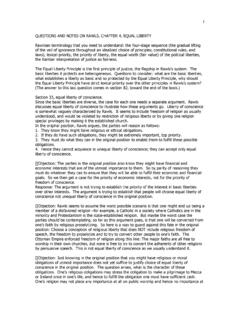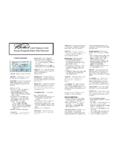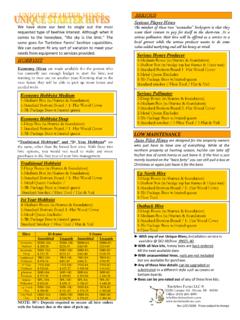Transcription of BEGINNING BEEKEEPERS WORKSHOP - Scientific Beekeeping
1 BEGINNING BEEKEEPERS WORKSHOP . Instructor: Randy Oliver (530) 277-4450 I suggest that you read each section of this outline in advance, so that you can better learn from the presentation during class itself. For current information on class details and field sessions, rather than phoning me, please go to: CLASS OUTLINE. (Class #1)/ 8:00 INTRODUCTION. Class outline History of Beekeeping Slide show--Basic honeybee biology 9:00 GETTING STARTED. Apiary location Equipment Tools and protective gear (Class #2)/ 10:00 BEE HUSBANDRY. Slide show Bee Husbandry in a Nutshell 11:00 WORKING WITH BEES. Sting avoidance and treatment, immunity and allergy (handout). Bee behavior; Understanding and handling bees Moving, trucking, lifting, and combining colonies 12:00 LUNCH BREAK.
2 1:00 FIELD SESSION--Open up some beehives (Class #3)/ 2:00 PESTS, PARASITES, AND PROBLEMS. Problems--Focus on Varroa and American foulbrood (Class #4)/ 3:00 GETTING STARTED AND SEASONAL MANAGEMENT. Slide show Starting with bees Colonies, nucs, packages, swarms New colony management 4:15 REVIEW AND QUESTIONS. Randy Oliver 2013 Page 1 of 45 Unauthorized copying or distribution prohibited. CONTENTS. FIELD SESSIONS .. 2. INTRODUCTION .. 4. BASIC HONEYBEE BIOLOGY (Slide show ).. Error! Bookmark not defined. GETTING 6. Randy's Equipment Recommendations (for non-migratory hobbyists) .. 6. APIARY LOCATION & MAINTENANCE .. 8. BUYING BEES TO GET 9. HOW TO WORK WITH BEES .. 10. LIFTING, MOVING AND TRUCKING COLONIES .. 16. QUEENS .. 17.
3 SEASONAL MANAGEMENT SUMMARY (phenological table) .. 21. BASIC Beekeeping MANAGEMENT (also slides) .. 22. SWARMING .. 25. FEEDING COLONIES .. 30. DISEASES, PESTS, AND PROBLEMS .. 31. Deadout Forensics in a Nutshell .. 32. HONEY NOTES AND OTHER PRODUCTS OF THE HIVE .. 41. Advice from Randy .. 43. FIRST YEAR CARE FOR YOUR NUC .. 45. All material in this syllabus is copyrighted by Randy Oliver. If you have received this document electronically from Randy, you have permission to print one copy for your own use. FIELD SESSIONS. Field sessions will usually be held at my home. We will only work bees on clear, warm days under ideal conditions. Always call my number (272-4450) the morning of a formal session to confirm that the session will be held.
4 I will leave a message on the machine. For informal apprenticeship, call my cell ( ). Randy Oliver 2013 Page 2 of 45 Unauthorized copying or distribution prohibited. I will supply veils and hive tools for the first session. For subsequent sessions you should bring your own smoker, hive tool, and veil. I strongly encourage everyone to work without gloves. You are welcome to wear coveralls and boots, but light-colored, long-sleeve cotton work clothing is fine (two layers of clothing will stop bee stings). Shoes (as opposed to sandals) and cotton socks are recommended. Please do not wear black or red clothing, wool or felt, wristwatches, or dark glasses. If you have any trouble reading this line in dim light, bring reading glasses.
5 Bring a lunch and drink if the session spans noontime. Checklist Call 272-4450 to confirm Smoker Veil Hive tool Light clothes or coveralls Shoes or boots Reading glasses (bee eggs are tiny). Lunch and drink Directions from I-80 east GPS works well. Take the Colfax/Grass Valley offramp. Keep turning right until you are on Hwy 174. Don't miss when 174 turns left a mile out of town at Giovanni's restaurant! Go 1/4 mi past Meadow View Drive (about 6 miles from Colfax). Turn left on Meadow Drive. Go miles up. Address 14744 on right. Randy Oliver 2013 Page 3 of 45 Unauthorized copying or distribution prohibited. BEGINNING BEEKEEPERS WORKSHOP . Instructor: Randy Oliver (530) 277-4450. INTRODUCTION. BEES AND MAN. Many species of bees--about 3500 in Honeybees evolved in Europe, Africa, and Asia Very important in Man's history Wild bees source of honey, brood, and pollen Domesticated bees source of honey (no sugar) and wax (no oil).
6 Tax records for beeswax Honeybees were brought to North America by early European settlers Brought to Calif. by boat in early 1850'S. Early bees kept in gums Rev. Langstroth invented movable frame hive with beespace (5/16") in 1851. Now about 300,000 BEEKEEPERS in , about 2000-3000 commercial; total about 3. million colonies 95% have fewer than 25 colonies; 4% 25-99 colonies; 1% run up to 80,000 with crew Very important for pollination--about $15 billion 90% of paid pollination on West Coast; 70% in Calif. YOU AS A BEEKEEPER. Hobby and sideline BEEKEEPERS --don't copy commercial CALIFORNIA AS Beekeeping ENVIRONMENT. Seasons, honeyflows, yields, management earlier than books Who can keep bees-- Time and strength needed BEEKEEPERS vs.
7 Bee havers--need to stay on top of varroa! ALLERGY. APIARY SITING--ALMOST ANYWHERE, COVERED LATER. Neighbors and responsibilty--water, swarming, flight path Randy Oliver 2013 Page 4 of 45 Unauthorized copying or distribution prohibited. COSTS. Handling gear--one time ($150). Woodenware--new or used; danger of used ($200 each, new). Total for two colonies & gear--easily $600. Bees, queens--more later Where to buy--catalogs, local LEARNING TO KEEP BEES. Apprentice to experienced beekeeper!!!!! Bee class--formed to avoid mistakes Join Association political presence; support group; local--WAS, CSBA. Subscribe to journals READING & RESOURCES. BEGINNING texts Honey Bee Hobbyist by Norm Gary good overall understanding, rather than how-to First Lessons in Beekeeping , Dadant The Beekeeper's Handbook by Diana Sammataro & Alfonse Avitabile Homegrown Honey Bees by Alethea Morrison Great beginners book free download: Beekeeping for Dummies Beekeeping in California click "downloads".
8 The Honey Revolution: Restoring the Health of Future Generations by Ron Fessenden Almond Pollination Handbook Traynor References The Hive and the Honey Bee, Dadant ABC and XYZ of Bee Culture, Root The Biology of the Honey Bee, Winston Beautiful prose A Book of Bees, Hubble Journals American Bee Journal Bee Culture Randy Oliver 2013 Page 5 of 45 Unauthorized copying or distribution prohibited. Extension Apiculturist Dr. Eric Mussen (530) 752-0472 ecmussen@ ;. Eric is our "deep pocket" of Beekeeping information Newsletter On the Web So many sites; so much erroneous information! Take everything with a grain of salt! Most accurate and up to date is GETTING STARTED. THE RIGHT WAY TO KEEP BEES. There is no one "right" way to keep bees.
9 If you ask a dozen BEEKEEPERS for the "best" way to do something, they may all give you a different answer, and they may all be correct (or incorrect!). The right way for you depends upon what you want to get out of Beekeeping , your constraints of time and money, whether it is for profit or enjoyment, your location, and many other factors. In this class, I will suggest general proven methods that will get you off to a good start. Where you go from there is up to you! The rules for Beekeeping : RANDY'S EQUIPMENT RECOMMENDATIONS (FOR NON-MIGRATORY HOBBYISTS). (support your local Beekeeping suppliers). TOOLS & GEAR. Smoker: 4" x 7" (I prefer dome-top stainless steel with narrow spout). Hive tool--regular (get at least two). Nylon bee brush Zipper-veil, plastic-helmeted or hooded coverall bee suit Extra string tie veil and helmet for light work or guests Goatskin gloves with nylon cuffs--oil gloves before using, then whenever stiff Rubber steel-toed rain boots--tuck pants inside HIVE EQUIPMENT.
10 Randy Oliver 2013 Page 6 of 45 Unauthorized copying or distribution prohibited. Boxes: Use commercial or budget grade, good oil-based primer to outer surfaces only. Then high quality oil or latex top coat. (Sherwin Williams A 100 gets good reviews). Not worth cutting your own pine. Square up during assy. Outside dimensions are 16-5/16" x 19-7/8". Use 7d galvanized nails or 1- 3/4" staples each way in corners. Stick with one brand, since dimensions are not uniform. BOX SIZES. For brood chambers, the commercial standard is deep equipment (9-5/8 depth). Many advantages, but boxes of honey are heavy (up to 90 lbs). In order to get around the weight issue, some use medium . depth (6-5/8 ). Another alternative is to go to 8-frame deeps.








